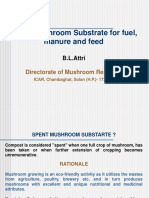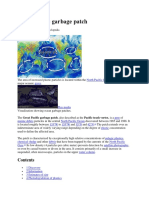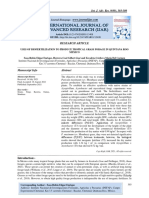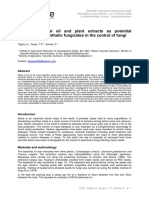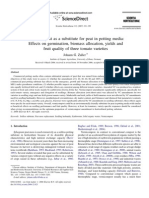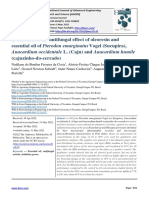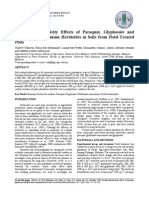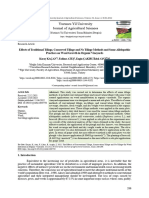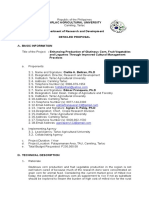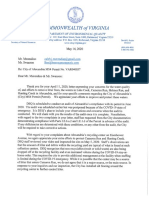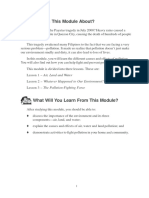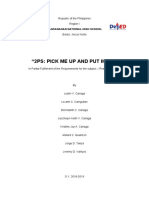Professional Documents
Culture Documents
Evaluation of Growth Parameters of Tomato Seeds Planted in Crude Oil Polluted Soil Remediated With Strains of Bacillus Subtilis and
Original Title
Copyright
Available Formats
Share this document
Did you find this document useful?
Is this content inappropriate?
Report this DocumentCopyright:
Available Formats
Evaluation of Growth Parameters of Tomato Seeds Planted in Crude Oil Polluted Soil Remediated With Strains of Bacillus Subtilis and
Copyright:
Available Formats
Volume 8, Issue 6, June – 2023 International Journal of Innovative Science and Research Technology
ISSN No:-2456-2165
Evaluation of Growth Parameters of Tomato Seeds
Planted in Crude Oil Polluted Soil Remediated
with Strains of Bacillus subtilis and
Pseudomonas aeruginosa
1
Onuoha, U.N. ; 2Appeh, G.O.
1
Department of Microbiology, Michael Okpara University of Agriculture,
Umudike Abia State, Nigeria
Abstract:- The beneficial effects of bioremediation with I. INTRODUCTION
oil-degrading microorganism, Pseudomonas aeruginosa
and Bacillus subtilis, on tomato seedlings growth in oil- Pollution of arable land by industrial effluents, liquid
contaminated soil was investigated. The effect of wastes such as crude petroleum, including gaseous
bioremediation was examined with Pseudomonas petroleum products, are common phenomenon in many
aeruginosa and Bacillus subtilis on phytotoxicity, as countries of the world. This is especially true of oil
measured by tomato seed growth. Tomato growth producing countries (Basumatory et al., 2012; Nwaugo et
parameters (leaf length, height, seed germination, al., 2007; Brooijmans et al., 2009).
chlorosis, stunted growth) were evaluated daily for
15days. In the experimental samples that was polluted Crude oil contamination is a serious environmental
with crude petroleum and inoculated with Pseudomonas threat for soil and plants growing in it. Contamination of soil
aeruginosa, the percentage seed germination was 99% with oil results in serious depression of growth of most
while the seedlings reached a mean height of plants, primarily due to its effects on the physical and
66.9±0.20mm with mean leaf length of 8.1±0.10mm, chemical properties of soil and soil water properties. Crude
while in the control set-up without the isolate, percentage oil affects the environment by changing the essential
seed germination, height and leaf length were 39%, elements of habitat. To overcome this problem, different soil
38.6% and 4.4mm respectively. Records from remediation technologies have been developed such as soil
experimental sample inoculated with Bacillus subtilis, washing with surfactants, biological treatment, thermal
percentage seed germination at the end of the 15days treatment, etc. Bioremediation has the potential to change
monitoring period was 98%, while mean height of the the soil physicochemical properties (Brennan et al., 2014),
tomato seedlings was 66.0±0.20mm and mean length was improve the water holding capacities of soil (Evangelou et
7.9±0.20mm, at the end of the monitoring period was al., 2014) eventually resulting in increased soil fertility (Mia
3.2±0.20mm. Some qualitative morphological et al., 2017); with potential beneficial effects on crop
observations made on the seedlings were also observed productivity, plant establishment, and growth (Brennan et
for seedlings. In the untreated control as well as the al., 2014).
treated experimental samples (Pseudomonas aeruginosa
and Bacillus subtilis), sprouting of the seeds were rapid Bioassays such as measurements of seed germination
and completed in a few days, the seedlings showed steady and early seedling growth have been used to monitor
growth and morphologically normal. In the control soils treatment effects and restoration of oil-contaminated sites
however, sprouting was sluggish, and growth was (Sverdrup et al., 2003). Dorn and Salanitro (2000) found
stunted, yellowing of the leaves was observed (chlorosis); that seed germination and plant growth using corn, wheat,
a number of the seedlings were folded at the tips. These and oats differed from different soils and oil combinations
were indications of phytotoxicity resulting from oil before, during, and after bioremediation. Sayles et al. (1999)
pollution. The results of the present research have showed that oil-contaminated soil treated with aerobic
proven the bioremediation potential of bacterial isolates, biodegradation was less toxic to lettuce and oat root
for crude oil contamination which also showed elongation. Hanson et al. (2007) reported that Acinetobacter
significant growth potential for the tomato seeds. sp. A3-treated soil permitted better germination and growth
of mungbeans, as evidenced by better plant length, weight,
Keywords:- Phytotoxicity, Pollution, Crude Oil, and leaf chlorophyll content. This indicated that
Pseudomonas aeruginosa, Tomatoes. Acinetobacter sp. A3 was capable of reducing crude oil
phytotoxicity through biodegradation.
IJISRT23JUN974 www.ijisrt.com 2860
Volume 8, Issue 6, June – 2023 International Journal of Innovative Science and Research Technology
ISSN No:-2456-2165
Considering the detrimental effects of crude oil III. RESULTS AND DISCUSSION
pollution on plants and its attendant implications for food
security and environmental integrity in oil rich regions, it The percentage seed germination of the tomato seeds
has become necessary to preserve the available arable land (Lycopesicon esculetum) and the mean seedling height; The
through bioremediation approaches mean leaf length and the mean largest leaf breath of the
experimental set ups (ESU) as well as Control 1 (C1),
In this study, we investigated the remediation of crude Control 2 (C2) and Control 3 (C3), are presented in Tables 1
oil contaminated soil using isolates of Bacillus subtilis and to 4 for polluted soils bioremediated with polluted with
Pseudomonas aeruginosa. Treated soils were used to study Pseudomonas aeruginosa and Bacillus subtilis respectively;
the germination of tomato seedlings and its morphological, for 15days, which marked the end of the monitoring period
and physiological responses were used as indicators for soil for planting. 100% percentage seed germination was
toxicity. observed in the untreated control samples (C3), while the
mean height of the seedlings was 71.0±0.20mm. Mean leaf
II. METHODS length recorded was 8.9±0.00mm while the largest leaf
breath was 3.8±0.20mm. In the experimental samples that
Study Design was polluted with crude petroleum and inoculated with
Experiments to achieve ex-situ bioremediation were Pseudomonas aeruginosa, the percentage seed germination
set up in sizable plastic containers of equal dimensions. 5% was 99% while the seedlings reached a mean height of
pollution of the freshly obtained garden soil sample was 66.9±0.20mm. The mean leaf length observed for this set up
prepared in the laboratory set ups designated as follow: was 8.1±0.10mm, while the mean largest leaf breath was
3.3±0.00mm. For the control set ups of sample A; the
Experimental set up (ESU) which contained polluted records were as follows: percentage seed germination for
agricultural soil (5% v/w) and 250ml of the controls 1and 2 are 39.0% and 35.0% respectively, while
Pseudomonas aeruginosa broth at its exponential the mean height of seedlings for same controls were
growth phase evenly dispersed all over the set up. 38.6±0.00mm for control 1 and 36.8±0.00 for control 2
A second but similarly designed representing control 1 respectively. The mean leaf length of sample A controls
(CSU 1) which contained the polluted agricultural soil were: 4.4±0.00mm for control 1 and 4.1±0.10 for control 2
(5%v/w) and 250ml sterile prepared microbiological respectively, while the largest leaf breath recorded were,
media (UDBB), but devoid of any microorganism and 2.5±0.10mm for control 1 and 2.2±0.20mm for control 2
evenly dispersed in the soil. respectively(Tables 1 and 2)
A third also similarly designed representing control 2
(CSU 2) which contained the polluted agricultural soil Records from experimental sample B and controls
(5%v/w) and 250ml sterile distilled water (SDW) which was crude petroleum polluted agricultural soil, seeded
evenly dispersed all over the soil. with Bacillus subtilis are presented in Table 3 and 4. The
record shows the following values: The percentage seed
The above designs were set up for both Pseudomonas germination at the end of the 15days monitoring period is
aeruginosa denoted sample A and for Bacillus subtilis 98%, while mean height of the tomato seedlings was
denoted sample B. 66.0±0.20mm ; mean length length recorded was
7.9±0.20mm, while the largest leaf breath at the end of the
Testing for Decontamination of the Polluted Soil monitoring period was 3.2±0.20mm.
The experimental and control soils were examined
nine (9) weeks after bioremediation of the oil pollution From the control soils, at the end of the 15day
treatment process. This was to check the recovery of the monitoring period, percentage seed germination recorded
agricultural soil from the oil impaction. To achieve this test, was 38.0% and 34.0% for B controls 1 and 2 respectively.
100 Tomato seeds (Lycopersicon esculantum) were planted The mean height of seedlings was 38.0±0.10mm for controls
per replicate set up and the results obtained compared to 1 and 36.1±0.20mm for control 2.The mean leaf length for
those of a third control (contr 3) which was not treated controls 1 and 2 were 3.8±0.40mm and 3.6±0.10mm
(untreated and unpolluted agricultural soil). The seeds were respectively, while the largest leaf breath were 2.4± 0.00mm
watered at weekly intervals and the daily records of: for control 1 and 1.9 ±0.00mm for control 2.
Number of germination, their morphology, mean seedling
height, mean length of leaves and mean leaf breadth were Some qualitative morphological observations made on
taken. Observations e.g leaf folds/curls, leaf droppings, the seedlings were also recorded in Table 5 for sample A
chlorosis, stunted growth etc were also made (Akujobi et al., soils treated with Pseudomonas aeruginosa, and Table 6 for
2011). sample B soils treated with Bacillus subtilis. In the untreated
control (C3) as well as the treated experimental samples A
and B, sprouting of the seeds were rapid and completed in a
few days, the seedlings showed steady growth and
morphologically normal. In the control soils however,
sprouting was sluggish, and when they did sprout, growth
was stunted, yellowing of the leaves was observed
(chlorosis); A number of the seedlings were folded at the
IJISRT23JUN974 www.ijisrt.com 2861
Volume 8, Issue 6, June – 2023 International Journal of Innovative Science and Research Technology
ISSN No:-2456-2165
tips while their stems were pale and etiolated. These were the control stems with leaves felled and dropped on their
indications of phytotoxicity resulting from oil. A number of sides.
Table 1 Mean percentage seed germination (%) and height of seedlings (mm) of tomato seedlings (Lycopersicon esculetum)
planted in crude petroleum polluted agricultural soil after bioremediation using Pseudomonas aeruginosa [SAMPLES A]
Mean Percentage Seed Germination (%) Mean Height Of Seedling ( mm)
Time in Days Exptl Contr 1 Contr 2 Contr 3 Exptl Contr 1 Contr 2 Contr 3
0 0.0±0.00 0.0±0.00 0.0±0.00 0.0±0.00 0.0±0.00 0.0±0.00 0.0±0.00 0.0±0.00
1 0.0±0.00 0.0±0.00 0.0±0.00 0.0±0.00 0.0±0.00 0.0±0.00 0.0±0.00 0.0±0.00
2 0.0±0.00 0.0±0.00 0.0±0.00 0.0±0.00 0.0±0.00 0.0±0.00 0.0±0.00 0.0±0.00
3 4.0±0.50 0.0±0.00 0.0±0.00 5.0±0.50 5.0±0.50 0.0±0.00 0.0±0.00 3.8±0.10
4 20.0±0.30 2.0±0.50 1.0±0.50 25.0±0.50 4.6±0.00 1.2±0.10 1.0±0.10 6.2±0.10
5 25.0±0.20 8.0±0.50 3.0±0.00 30.0±0.00 10.2±0.00 3.4±0.10 2.1±0.00 14.8±0.00
6 32.0±0.10 8.0±0.50 9.0±0.00 42.0±0.50 20.2±0.00 6.1±0.10 5.9±0.10 22.6±0.10
7 45.0±0.50 23.0±0.00 22.0±0.50 68.0±0.00 28.0±0.10 8.6±0.10 6.1±0.10 30.0±0.10
8 58.0±0.30 26.0±0.50 24.0±0.00 82.0±0.50 34.2±0.10 14.6±0.10 12.5±0.00 38.8±0.30
9 62.0±0.20 32.0±0.00 26.0±0.00 96.0±0.00 40.4±0.10 20.1±0.00 18.8±0.10 46.9±0.40
10 71.0±0.20 34.0±0.50 29.0±0.00 100.0±0.00 46.5±0.00 34.9±0.00 21.5±0.10 50.4±0.10
11 86.0±0.10 36.0±0.50 30.0±0.50 100.0±0.00 52.8±0.00 28.0±0.00 22.4±0.00 58.8±0.20
12 92.0±0.00 38.0±0.50 32.0±0.50 100.0±0.00 59.4±0.10 30.1±0.00 28.2±0.10 62.5±0.00
13 97.0±0.00 38.0±0.50 32.0±0.50 100.0±0.00 62.0±0.20 32.2±0.10 31.1±0.10 62.6±0.00
14 99.0±0.10 38.0±0.00 33.0±0.00 100.0±0.00 48.5±0.10 36.8±0.20 33.4±0.20 68.1±0.10
15 99.0±0.00 38.0±0.00 33.0±0.00 100.0±0.00 66.9±0.20 38.0±0.00 36.9±0.00 69.0±0.00
Table 2 Mean leaf length (mm) and largest leaf breath (mm) of tomato seedlings (Lycopersicon esculetum) planted in crude
petroleum polluted agricultural soil after bioremediation using Pseudomonas aeruginosa [Sample A]
Mean Leaf Length (mm) Mean Largest Leaf Breath (mm)
Time in days Exptl Contr 1 Contr 2 Contr 3 Exptl Contr 1 Contr 2 Contr 3
0 0.0±0.00 0.0±0.00 0.0±0.00 0.0±0.00 0.0±0.00 0.0±0.00 0.0±0.00 0.0±0.00
2 0.0±0.00 0.0±0.00 0.0±0.00 0.0±0.00 0.0±0.00 0.0±0.00 0.0±0.00 0.0±0.00
3 0.0±0.00 0.0±0.00 0.0±0.00 0.0±0.00 0.0±0.00 0.0±0.00 0.0±0.00 0.0±0.00
4 0.0±0.00 0.0±0.00 0.0±0.00 2.6±0.10 1.2±0.10 0.0±0.00 0.0±0.00 1.4±0.20
5 2.0±0.10 1.0±0.10 0.0±0.0 3.0±0.10 1.2±0.10 0.1±0.10 0.2±0.10 1.6±0.10
6 2.9±0.30 1.3±0.00 1.0±0.10 3.6±0.10 1.5±0.30 0.6±0.40 0.4±0.20 1.0±0.10
7 0.40 1.6±0.20 1.2±0.20 4.0±0.10 1.6±0.10 1.2±0.10 0.6±0.10 1.9±0.20
8 4.6±0.10 2.0±0.20 1.7±0.30 4.0±0.30 1.8±0.20 1.3±0.00 1.2±0.20 2.0±0.10
9 5.2±0.20 2.2±0.20 2.0±0.00 4.5±0.20 2.1±0.20 1.3±0.00 1.2±0.20 2.4±0.30
10 5.9±0.30 2.6±0.10 2.1±0.10 5.0±0.40 2.2±0.30 1.5±0.10 1.3±0.10 2.7±0.20
11 6.5±0.10 3.2±0.20 2.3±0.30 5.8±0.10 2.4±0.40 1.7±0.30 1.4±0.10 2.9±0.10
12 7.1±0.10 3.6±0.40 2.5±0.30 6.8±0.20 2.6±0.20 1.9±0.10 1.5±0.20 3.0±0.00
13 7.2±0.20 3.6±0.10 2.8±0.30 7.9±0.00 2.8±0.00 2.2±0.10 1.6±0.10 3.3±0.20
14 7.4±0.20 3.6±0.10 2.8±0.20 8.0±0.10 3.0±0.10 2.3±0.20 1.8±0.10 3.5±0.40
15 7.8±0.10 3.8±0.10 2.9±0.10 8.0±0.10 3.1±0.10 2.4±0.10 1.9±0.00 3.8±0.20
16 8.0±0.10 3.8±0.10 2.9±0.10 8.1±0.00 3.2±0.00 2.5±0.10 2.2±0.20 3.8±0.20
Table 3 Mean percentage seed germination (%) and height of seedlings (mm) of tomato seedlings (Lycopersicon esculetum)
planted in crude petroleum polluted agricultural soil after bioremediation using Bacillus subtilus [SAMPLES B]
Mean Percentage Seed Germination (%) Mean Height of Seedling ( mm)
Time in days Exptl Contr 1 Contr 2 Contr 3 Exptl Contr 1 Contr 2 Contr 3
0 0.0±0.00 0.0±0.00 0.0±0.00 0.0±0.00 0.0±0.00 0.0±0.00 0.0±0.00 0.0±0.00
1 0.0±0.00 0.0±0.00 0.0±0.00 0.0±0.00 0.0±0.00 0.0±0.00 0.0±0.00 0.0±0.00
2 0.0±0.00 0.0±0.00 0.0±0.00 0.0±0.00 0.0±0.00 0.0±0.00 0.0±0.00 0.0±0.00
3 1.0±0.20 0.0±0.00 0.0±0.00 5.0±0.10 2.0±0.00 1.0±0.20 0.0±0.00 3.8±0.50
4 3.0±0.30 0.0±0.00 1.0±0.20 25. 0±0.40 3.2±0.50 1.1±0.10 1.1±0.40 6.2±0.20
5 26.0±0.20 6.0±0.10 1.0±0.10 30.0±0.10 6.6±0.30 2.4±0.30 1.9±0.40 14.8±0.40
6 37.0±0.10 20.0±0.10 8.0±0.30 42.0±0.30 16.9±0.20 5.5±0.20 4.0±0.20 22.6±0.00
7 40.0±0.00 23.0±0.30 20.0±0.30 68.0±0.20 26.4±0.10 8.6±0.40 6.2±0.30 30.0±0.10
8 50.0±0.50 27.0±0.40 22.0±0.20 82.0±0.10 30.5±0.00 14.0±0.30 12.9±0.10 38.8±0.20
9 68.0±0.10 30.0±0.20 28.0±0.10 96.0±0.30 36.2±0.40 16.4±0.20 15.0±0.40 46.9±0.40
IJISRT23JUN974 www.ijisrt.com 2862
Volume 8, Issue 6, June – 2023 International Journal of Innovative Science and Research Technology
ISSN No:-2456-2165
10 78.0±0.10 34.0±0.30 29.0±0.10 100.0±0.00 42.1±0.30 20.5±0.30 18.9±0.20 50.4±0.30
11 82.0±0.10 36.0±0.10 30.0±0.10 100.0±0.00 50.5±0.10 26.2±0.10 26.4±0.00 58.8±0.10
12 88.0±0.40 38.0±0.30 33.0±0.40 100.0±0.00 55.9±0.50 30.1±0.00 27.0±0.50 62.5±0.30
13 96.0±0.30 38.0±0.00 33.0±0.20 100.0±0.00 60.1±0.30 33.0±0.20 30.1±0.40 65.6±0.20
14 98.0±0.10 38.0±0.00 34.0±0.50 100.0±0.00 62.0±0.00 36.6±0.30 34.2±0.10 68.1±0.10
15 98.0±0.10 39.0±0.20 34.0±0.00 100.0±0.00 66.2±0.20 39.8±0.10 36.3±0.20 71.0±0.20
Table 4 Mean leaf length (mm) and largest leaf breath (mm) of tomato seedlings (Lycopersicon esculetum) planted in crude
petroleum polluted agricultural soil after bioremediation using Bacillus subtilus [SAMPLE B]
Mean leaf length (mm) Mean largest leaf breath (mm)
Time in days Exptl Contr 1 Contr 2 Contr 3 Exptl Contr 1 Contr 2 Contr 3
0 0.0±0.00 0.0±0.00 0.0±0.00 0.0±0.00 0.0±0.00 0.0±0.00 0.0±0.00 0.0±0.00
1 0.0±0.00 0.0±0.00 0.0±0.00 0.0±0.00 0.0±0.00 0.0±0.00 0.0±0.00 0.0±0.00
2 0.0±0.00 0.0±0.00 0.0±0.00 0.0±0.00 0.0±0.00 0.0±0.00 0.0±0.00 0.0±0.00
3 0.0±0.00 1.0±0.00 0.0±0.00 0.0±0.00 0.0±0.00 0.0±0.00 0.0±0.00 1.4±0.20
4 1.6±0.10 1.0±0.10 0.0±0.00 3.0±0.10 1.1±0.50 0.1±0.10 0.15±0.10 1.6±0.50
5 2.5±0.40 1.1±0.20 1.0±0.20 3.6±0.30 1.3±0.30 0.4±0.30 0.4±0.10 1.6±0.40
6 3.1±0.20 1.3±0.00 1.2±0.10 4.0±0.40 1.5±0.10 1.0±0.30 0.4±0.10 1.9±0.20
7 4.4±0.00 1.8±0.10 1.5±0.00 4.0±0.40 1.7±0.20 1.2±0.40 0.8±0.10 2.0±0.30
8 4.9±0.00 1.9±0.20 1.9±.040 4.5±0.30 2.1±10 1.2±0.40 1.1±0.20 2.4±0.40
9 5.8±0.10 2.4±0.10 1.9±0.40 5.0±0.10 2.3±0.30 1.4±0.20 1.2±0.10 2.7±0.30
10 6.4±0.20 3.3±0.40 2.4±0.30 5.8±0.30 2.3±0.30 1.6±0.30 1.4±0.30 2.9±0.20
11 6.4±0.10 3.6±0.10 2.6±0.10 6.8±0.10 2.5±0.40 1.85±0.20 1.6±0.40 3.0±0.20
12 7.3±0.20 37.1±0.10 2.8±0.00 7.9±0.00 2.8±0.50 1.3±0.40 1.7±0.10 3.3±0.30
13 7.3±0.00 4.4±0.40 2.9±0.10 8.0±0.10 2.7±0.20 2.3±0.10 1.8±040 3.5±0.10
14 7.9±0.20 4.4±0.40 2.9±0.10 8.0±0.10 3.2±0.30 2.4±0.10 1.9±0.10 3.8±0.00
15 7.9±0.20 4.4±0.40 3.0±0.10 8.1±0.10 3.2±0.20 2.4±0.00 1.9±0.00 3.8±0.10
Table 5 Some morphological observation made on the tomatoes seedlings (Lycopersicon esculentum) on polluted agricultural soil
after bioremediation using Pseudomonas aeruginosa
Legend
NG = No germination seen yet
― = Absent
+ = Present
++ = Higher percentage present
+++ = Highest percentage present
IJISRT23JUN974 www.ijisrt.com 2863
Volume 8, Issue 6, June – 2023 International Journal of Innovative Science and Research Technology
ISSN No:-2456-2165
Table 6 Some Morphological Observations Made on the Tomato Seedlings (Lycopersicon Esculetum) Planted on Crude Petroleum
Polluted Soil After Biomediation Using Bacillus Subtilus [SAMPLE B]
Legend
NG = No germination seen yet
- = Absent
+ = Present
++ = Higher percentage present
+++ = Highest percentage present
IV. DISCUSSIONS the experimental soil samples. From the results obtained, the
recovery effects were better in the experimental and
Crude oil contamination affects the agriculture sector unpolluted soil samples in contrast to the controls. The
particularly due to soil toxicity and reduced plant growth. result on plant height agrees with previous findings of
Crude oil causes environmental risks in the soil ecological Ikhajiagbe and Anoliefo (2011) on the significant reduction
system, by inhibition of plant growth, damage to soil of plant growth occasioned by oil pollution. Ojimba and
structure, disturbance of soil water quality (Han et al., Iyagba (2012) reported the decreased output of horticultural
2016). crops in crude oil polluted farms as compared with the
unpolluted farms.
The present research was designed to observe the
growth response of tomato seedlings in crude oil polluted Various studies have reported the role of these
soil samples remediated with isolates of Pseudomonas remediation techniques in the improvement of plant growth
aeruginosa and Bacillus subtilis. It was found that these (Shahid et al., 2017; Laird et al., 2010). Our results also
methods are not only beneficial to remediate the soil but relate with Laird et al. (2010), where fresh weight and dry
also capable to overcome the toxic nature of crude oil as weight increased because of remediation of the soil. Hence
evidenced by the improved growth performance of the it could be inferred that the isolates used in this study may
seedlings in comparison with the unpolluted soil. reduce the leaching losses of nutrients by causing retention
Phytotoxicity study showed that leaf breath, heights, seed of nutrients in the soil.
germination and leaves lengths of the plants were
significantly reduced in the samples planted in control soil Disturbances of major physiological processes within
relative to the experimental and unpolluted soils. The plants systems due to hydrocarbon contamination are
percentage increase recorded for seed germination and plant common; and manifest in the forms of morphological,
height in both experimental soils (P. aeruginosa and B. pigment, chlorotic and necrotic foliar patterns alterations. In
subtilis remediated) might be due to an increase in nutrient this study, only tomato seeds grown in experimental soil and
uptake by the plant and a decrease in crude oil uptake (Mosa unpolluted soil didn’t exhibit stunted growth, chlorosis and
et al., 2016). Increased microbial activities resulting in leaf folding/dropping. For plants grown in contaminated
reduced accumulation of crude oil residues made these soil, the parameters were not observed completely. This
nutrients available in the state that they were easily finding is not without precedence as some couples of
assimilated by the test plant. This resulted to the better plant investigations claimed similar results (Chuku et al., 2018;
yield indices observed, in terms of percentage seed Okonokhua et al., 2007). Studies by Kekere et al. (2011)
germination; plant height and plant leaf breath parameters in reported that there was no crop yield recorded in cowpea
IJISRT23JUN974 www.ijisrt.com 2864
Volume 8, Issue 6, June – 2023 International Journal of Innovative Science and Research Technology
ISSN No:-2456-2165
grown in contaminated soil due to plant mortality. They also [7]. Hanson, K.G., Nigam, A.N., Kapadia, M. and Desai,
observed that crude oil contamination at all intensities A.J. (2007). Bioremediation of crude oil
resulted in a significant reduction in leaf number when contamination with Acinetobacter sp. A3. Curr.
compared with the control treatment in a concentration- Microbiol., 35:191–193.
dependent manner. Our results correlate with Ali et al. [8]. Ikhajiagbe, B. & Anoliefo, G. O. (2011). Natural
(2017), who reported that crude oil adversely affects the attenuation of a 14- month-old waste engine oil
plant-water-soil relationship, resulting in chlorosis. The polluted soil. Journal of Soil Science and
relative plants' heights and the number of leaves were worst Environmental Management, 2(7), 184-192.
affected especially in plants grown in crude oil tainted soils [9]. Kekere, O., Ikhajiagbe, B. and Apela, B. R. (2011).
where absence of leaves was observed at the end of the Effects of crude petroleum oil on the germination,
experiments. growth, and yield of Vigna unguiculata Walp L.
Journal of Agriculture and Biological Sciences,
V. CONCLUSION 2(6).158 – 165.
[10]. Laird, D. A. et al. (2010). Impact of biochar
The results of the present research have proven the amendments on the quality of a typical Midwestern
bioremediation potential of bacterial isolates, for crude oil agricultural soil. Geoderma 158(3–4):443–449.
contamination which also showed significant growth [11]. Mia, S., Dijkstra, F. A. & Singh, B. (2017). Long-
potential for the tomato plants. It enhanced the term ageing of biochar: A molecular understanding
morphological, physiological, and biochemical parameters with agricultural and environmental implications.
of the plant. The P. aeruginosa bioaugmented soil showed Adv. Agron. 141:1–51.
better indices than B subtilis; this again points to the higher [12]. Mosa, A., El-Banna, M. F. & Gao, B. (2016). Biochar
potentials of Pseudomonas aeruginosa than Bacillus filters reduced the toxic effects of nickel on tomato
Subtilis. From the above observations, the bioremediation (Lycopersicum esculentum L.) grown in nutrient film
process increased the fertility index of the crude petroleum technique hydroponic system’. Chemosphere 149,
polluted agricultural soils. 254–262.
[13]. Ojimba, T.P. & Iyagba, A. G. (2012). Effects of crude
REFERENCES oil pollution on Horticultural crops in Rivers State,
Nigeria. Global Journal of Science Frontier Research
[1]. Ali, B. A. A., Ali, H. H. & Shaker, G. A. (2017). The Agriculture and Biology, 12(4):37-43.
impact of ascending levels of crude oil pollution on [14]. Okonokhua, B.O., Ikhajiagbe, B., Anoliefo, G.O. and
growth of olive (Olea europaea Linn.) seedlings. Ibn Emede, T.O. (2007). The Effects of Spent Engine Oil
AL-Haitham J. Pure Appl. Sci. 22(3):1. on Soil Properties and Growth of Maize (Zea mays
[2]. Brennan, A., Jiménez, E. M., Alburquerque, J. A., L.). J. Appl. Sci. Environ. Manage., 11 (3):147 – 152.
Knapp, C. W. & Switzer, C. (2014). Effects of [15]. Sayles, G.D., Acheson, C.M., Kupferle, M.J., Shan,
biochar and activated carbon amendment on maize Y., Zhou, Q., Meier, J.R., Chang, L. and Brenner,
growth and the uptake and measured availability of R.C. (1999). Treatment of PAH-contaminated soil:
polycyclic aromatic hydrocarbons (PAHs) and performance measured by chemical and toxicity
potentially toxic elements (PTEs). Environ Pollut. assays. Environ. Sci. Technol., 33:4310–4317.
193:79–87. [16]. Shahid, H., Iqbal, M., Shafiq, M. & Athar, M. (2017).
[3]. Chuku, O.S., Ekweozor, I. K. E. and Jaja, E. T. Effects of crude oil polluted soil on the seedling
(2018). Effects of Crude Oil on Fresh and Dry growth of Pennisetum Blaucum (L.). J. Plant Dev.
Weights of solanum melongena, Phaseolus vulgaris, 24:33–43.
and Cucumis sativus Amended with Leaf Litter and [17]. Sverdrup, L.E., Krogh, P.H., Nielsen, T., Kjær, C.
Hydrogen Peroxide. International Journal of Science and Stenersen, J. (2003). Toxicity of eight polycyclic
and Research; 7(12):1364-1368. aromatic compounds to red clover (Trifolium
[4]. Dorn, P.B. and Salanitro, J.P. (2000). Temporal pretense), ryegrass (Lolium perenne), and mustard
ecological assessment of oil contaminated soils (Sinapsis alba). Chemosphere, 53:993–1003.
before and after bioremediation. Chemosphere,
40:419–426.
[5]. Evangelou, M.H., Brem, A., Ugolini, F., Abiven, S.
& Schulin, R. (2014). Oil application of biochar
produced from biomass grown on trace element
contaminated land. J. Environ. Manage. 146:100–
106.
[6]. Han, T., Zhao, Z., Bartlam, M. & Wang, Y. (2016).
Combination of biochar amendment and
hytoremediation for hydrocarbon removal in
petroleum-contaminated soil. Environ. Sci. Pollut.
Res. 23:21219–21228.
IJISRT23JUN974 www.ijisrt.com 2865
You might also like
- Aspect Impact Analysis QADocument1 pageAspect Impact Analysis QAAtul SharmaNo ratings yet
- SMS Recycling BLADocument42 pagesSMS Recycling BLAShivendra SinghNo ratings yet
- Great Pacific Garbage PatchDocument57 pagesGreat Pacific Garbage PatchFadhla DielaNo ratings yet
- Biomedical Waste ManagementDocument18 pagesBiomedical Waste ManagementMeenu Dogra100% (1)
- Eco SpiritualityDocument7 pagesEco SpiritualityjoeflicrNo ratings yet
- (Cucumis Sativus L.) APPLIED WITH VERMICOMPOSTDocument23 pages(Cucumis Sativus L.) APPLIED WITH VERMICOMPOSTTishianie O. JunioNo ratings yet
- Indonesia Plastics 200619Document46 pagesIndonesia Plastics 200619Desy RsNo ratings yet
- Effect of Different Substrates On Vegetative Growth Characters of Tomato (Solanum Lycopersicum)Document8 pagesEffect of Different Substrates On Vegetative Growth Characters of Tomato (Solanum Lycopersicum)International Journal of Innovative Science and Research TechnologyNo ratings yet
- ATIC Volume 1 Issue 1 Pages 52-60Document9 pagesATIC Volume 1 Issue 1 Pages 52-60Jalel SaidiNo ratings yet
- Daferera Et Al. 2003 PhytopathogensDocument7 pagesDaferera Et Al. 2003 PhytopathogensManuel PerezNo ratings yet
- Biorremedacion de Suelos Contaminados para Luchar Contra La ToxicidadDocument8 pagesBiorremedacion de Suelos Contaminados para Luchar Contra La ToxicidadAura Victoria OlayaNo ratings yet
- Uba and Basil Publication 1Document6 pagesUba and Basil Publication 1Bright UbaNo ratings yet
- Pseudomonas Aeruginosa On The Organic ContentDocument8 pagesPseudomonas Aeruginosa On The Organic ContentIJEAB JournalNo ratings yet
- Infuence of Biosurfactant Producing Bacillus Tequilensis LK5.4 IsolateDocument12 pagesInfuence of Biosurfactant Producing Bacillus Tequilensis LK5.4 IsolatejeanpiereNo ratings yet
- Bouaoud 2017Document13 pagesBouaoud 2017Vansh AujlaNo ratings yet
- Salt StressDocument5 pagesSalt StressMahtab KhurshidNo ratings yet
- Mandic Et Al-1 PDFDocument7 pagesMandic Et Al-1 PDFLila BeatovićNo ratings yet
- Bioaugmentation AdedokunandAtagaDocument4 pagesBioaugmentation AdedokunandAtagaSadbin MiaNo ratings yet
- Effect of Glomus Fasciculatum On The Growth and Yield of Tomato (Solanum Lycopersicum L.) in Meloidogyne Incognita Infested SoilDocument3 pagesEffect of Glomus Fasciculatum On The Growth and Yield of Tomato (Solanum Lycopersicum L.) in Meloidogyne Incognita Infested SoilShailendra RajanNo ratings yet
- ShenLarissa LRA2019Document12 pagesShenLarissa LRA2019Wilton CardosoNo ratings yet
- Uses of Biofertilization To Produce Tropical Grass Forage in Quintana Roo MexicoDocument7 pagesUses of Biofertilization To Produce Tropical Grass Forage in Quintana Roo MexicoIJAR JOURNALNo ratings yet
- Agroecological Approach To Seed Protection Using Basil Essential OilDocument6 pagesAgroecological Approach To Seed Protection Using Basil Essential OilPaulo Ricardo Souza FariaNo ratings yet
- Phytotoxicity and Microbial Activities of Crude Oil Polluted Pristine Soil During Bioremediation With Saw Dust Amendment From Awka, NigeriaDocument8 pagesPhytotoxicity and Microbial Activities of Crude Oil Polluted Pristine Soil During Bioremediation With Saw Dust Amendment From Awka, NigeriaEditor IJTSRDNo ratings yet
- Corresponding Author. Mailing Address: Department of Biochemistry and Microbiology, IB, State University of São Paulo (UNESP), Av. 24 A, No. 1515Document6 pagesCorresponding Author. Mailing Address: Department of Biochemistry and Microbiology, IB, State University of São Paulo (UNESP), Av. 24 A, No. 1515Regine KouagoNo ratings yet
- O.42 - Essential Oil and Plant Extracts As Potential Substitutes To Synthetic Fungicides in The Control of FungiDocument3 pagesO.42 - Essential Oil and Plant Extracts As Potential Substitutes To Synthetic Fungicides in The Control of FungiRey Oyan FabeNo ratings yet
- The Effect of Sodium Hypochlorite Solutions On in Vitro Seedling Growth and Shoot Regeneration of Ax (Unum Usitatissimum)Document4 pagesThe Effect of Sodium Hypochlorite Solutions On in Vitro Seedling Growth and Shoot Regeneration of Ax (Unum Usitatissimum)LeeAceNo ratings yet
- Production of Oyster Mushroom On Different Substrates Using Cylindrical Block System R. C. Dey, K. M. Nasiruddin, M. S. Haque and M. A. Z. Al MunsurDocument6 pagesProduction of Oyster Mushroom On Different Substrates Using Cylindrical Block System R. C. Dey, K. M. Nasiruddin, M. S. Haque and M. A. Z. Al MunsurpilsamNo ratings yet
- Eucalyptus Citriodora Leaf ExtractDocument8 pagesEucalyptus Citriodora Leaf ExtractFor StudyNo ratings yet
- Chapter OneDocument7 pagesChapter Onechidiogo orji-oraemesiNo ratings yet
- Organic Substrate For Transplant Production in Organic Nurseries. A Review.Document23 pagesOrganic Substrate For Transplant Production in Organic Nurseries. A Review.VARGAS GARCIA RUTH DANIELANo ratings yet
- Artical 1706Document5 pagesArtical 1706birhanu mechaNo ratings yet
- Pengaruh Jumlah Tanaman Per Lubang Dan Jarak Tanam Terhadap Hasil TANAMAN KACANG TANAH (Arachis Hypogea, L.) VAR. KANCILDocument4 pagesPengaruh Jumlah Tanaman Per Lubang Dan Jarak Tanam Terhadap Hasil TANAMAN KACANG TANAH (Arachis Hypogea, L.) VAR. KANCILRulyanta Christine Zuhira ManaluNo ratings yet
- Bioscientific Review (BSR) :: HTTPS://SSC - Umt.Edu - Pk/Biosci/Home - AspxDocument8 pagesBioscientific Review (BSR) :: HTTPS://SSC - Umt.Edu - Pk/Biosci/Home - AspxUMT JournalsNo ratings yet
- The Inoculation Method Affects Colonization and Performance of Bacterial Inoculant Strains in The Phytoremediation of Soil Contaminated With Diesel OilDocument14 pagesThe Inoculation Method Affects Colonization and Performance of Bacterial Inoculant Strains in The Phytoremediation of Soil Contaminated With Diesel OilMuhammad ArslanNo ratings yet
- Effect of Chitosan and Chlorocholine Chloride On The Minituberization of Cocoyam (Xanthosoma Sagittifolium L. Schott)Document9 pagesEffect of Chitosan and Chlorocholine Chloride On The Minituberization of Cocoyam (Xanthosoma Sagittifolium L. Schott)IJEAB JournalNo ratings yet
- Management of Common Root Rot and Fusarium Foot Rot of WheatDocument7 pagesManagement of Common Root Rot and Fusarium Foot Rot of WheatIlija MileticNo ratings yet
- Test The Effect of Some Methods of BreakingDocument5 pagesTest The Effect of Some Methods of BreakingInternational Journal of Innovative Science and Research TechnologyNo ratings yet
- Zaller 1Document9 pagesZaller 1Gary L. NicholsNo ratings yet
- P. Srujana and Sunil ZachariaDocument9 pagesP. Srujana and Sunil ZachariaAvijanNo ratings yet
- Impact of Vermicompost On Growth, Yield and Quality of Tomato Plant (Lycopersicum Esculentum)Document4 pagesImpact of Vermicompost On Growth, Yield and Quality of Tomato Plant (Lycopersicum Esculentum)Kanhiya MahourNo ratings yet
- 7 Coninck2020Document15 pages7 Coninck2020Carlos Noel RuizNo ratings yet
- Field Evaluation of Microbial Derivatives For Management of Legume Pod Borer, Maruca Vitrata F. in Yard Long BeanDocument5 pagesField Evaluation of Microbial Derivatives For Management of Legume Pod Borer, Maruca Vitrata F. in Yard Long BeanRAC HawkeyeNo ratings yet
- A Study On Preventive Effects of Lawsonia Inermis L. Bioformulations Against Leaf Spot Disease of MaizeDocument43 pagesA Study On Preventive Effects of Lawsonia Inermis L. Bioformulations Against Leaf Spot Disease of MaizeTuấn Nguyen AnhNo ratings yet
- Characterization of New Bacterial Biocontrol Agents Acinetobacter, Grapevine Resistance Against Botrytis CinereaDocument12 pagesCharacterization of New Bacterial Biocontrol Agents Acinetobacter, Grapevine Resistance Against Botrytis CinerearicardoNo ratings yet
- 1 1 9 Junaidi PDFDocument9 pages1 1 9 Junaidi PDFZulfikasetiawanBudiNo ratings yet
- Artículo Indizado 2014 - Biofumigación-SolarizaciónDocument11 pagesArtículo Indizado 2014 - Biofumigación-Solarizacióncatay de la cruz fernando joseNo ratings yet
- Impact of Ultraviolet C Radiation and Ozone Application On The Physiological Quality of Organic Maize SeedsDocument6 pagesImpact of Ultraviolet C Radiation and Ozone Application On The Physiological Quality of Organic Maize SeedsIJAERS JOURNALNo ratings yet
- Soil Biology & BiochemistryDocument13 pagesSoil Biology & BiochemistryJorge CorderoNo ratings yet
- Rachael New PROJECT)Document31 pagesRachael New PROJECT)santosNo ratings yet
- Chitosan Application in Maize (Zea Mays) To Counteract The Effects of Abiotic Stress at Seedling LevelDocument8 pagesChitosan Application in Maize (Zea Mays) To Counteract The Effects of Abiotic Stress at Seedling LevelRamadi WiditaNo ratings yet
- JABPS - Volume 3 - Issue 2 - Pages 65-79Document15 pagesJABPS - Volume 3 - Issue 2 - Pages 65-79Diego Rojo MuñizNo ratings yet
- Formulations of Bacillus Spp. and Pseudomonas Root Rot Caused by Fusarium SolaniDocument6 pagesFormulations of Bacillus Spp. and Pseudomonas Root Rot Caused by Fusarium SolaniNelver MorenoNo ratings yet
- Evaluation of The Antifungal Effect of Oleoresin and Essential Oil of Pterodon Emarginatus Vogel (Sucupira), (Cajuzinho-Do-Cerrado)Document4 pagesEvaluation of The Antifungal Effect of Oleoresin and Essential Oil of Pterodon Emarginatus Vogel (Sucupira), (Cajuzinho-Do-Cerrado)IJAERS JOURNALNo ratings yet
- Granarius, Sitophilus Oryzae and Sitophilus ZeamaisDocument10 pagesGranarius, Sitophilus Oryzae and Sitophilus ZeamaisAinaneNo ratings yet
- Residual Phytotoxicity Effects of Paraquat, Glyphosate and Glufosinate-Ammonium Herbicides in Soils From Field-Treated PlotsDocument3 pagesResidual Phytotoxicity Effects of Paraquat, Glyphosate and Glufosinate-Ammonium Herbicides in Soils From Field-Treated PlotsTushar MalikNo ratings yet
- Compatibility Between Biopesticides Used To Control Grey Mould, Powdery Mildew and Whitefly On TomatoDocument8 pagesCompatibility Between Biopesticides Used To Control Grey Mould, Powdery Mildew and Whitefly On TomatoVictor Lauro Perez GarciaNo ratings yet
- Impact of Diazotrophic Bacteria On Germination and Growth of Tomato, With Bio-Control Effect, Isolated From Algerian SoilDocument7 pagesImpact of Diazotrophic Bacteria On Germination and Growth of Tomato, With Bio-Control Effect, Isolated From Algerian SoilsaidaNo ratings yet
- 1 s2.0 S094450131300116X MainDocument7 pages1 s2.0 S094450131300116X MainJorge CorderoNo ratings yet
- Trichoderma Harzianum: Influence of Carbon and Nitrogen Sources On The Spore YieldDocument6 pagesTrichoderma Harzianum: Influence of Carbon and Nitrogen Sources On The Spore YieldKaren Avalos VelaNo ratings yet
- Kacan Ates Cakit Akgun Yyutb Dergisi 2022Document14 pagesKacan Ates Cakit Akgun Yyutb Dergisi 2022fadimeatesNo ratings yet
- IJB Vol 16 No 5 P 280 283Document4 pagesIJB Vol 16 No 5 P 280 283S M Nazmul SumonNo ratings yet
- Impact of Maize Seed Moisture Content Reduction On Germination Parameters As Influenced by Sun DryingDocument5 pagesImpact of Maize Seed Moisture Content Reduction On Germination Parameters As Influenced by Sun DryingMamta AgarwalNo ratings yet
- Mungbean ResearchDocument12 pagesMungbean ResearchRobert John GabrielNo ratings yet
- Mass Production of AM Fungal Inoculum by Soil Based Pot CultureDocument5 pagesMass Production of AM Fungal Inoculum by Soil Based Pot CultureIJARBS JOURNALNo ratings yet
- Application of Game Theory in Solving Urban Water Challenges in Ibadan-North Local Government Area, Oyo State, NigeriaDocument9 pagesApplication of Game Theory in Solving Urban Water Challenges in Ibadan-North Local Government Area, Oyo State, NigeriaInternational Journal of Innovative Science and Research TechnologyNo ratings yet
- Exploring the Post-Annealing Influence on Stannous Oxide Thin Films via Chemical Bath Deposition Technique: Unveiling Structural, Optical, and Electrical DynamicsDocument7 pagesExploring the Post-Annealing Influence on Stannous Oxide Thin Films via Chemical Bath Deposition Technique: Unveiling Structural, Optical, and Electrical DynamicsInternational Journal of Innovative Science and Research TechnologyNo ratings yet
- A Study to Assess the Knowledge Regarding Teratogens Among the Husbands of Antenatal Mother Visiting Obstetrics and Gynecology OPD of Sharda Hospital, Greater Noida, UpDocument5 pagesA Study to Assess the Knowledge Regarding Teratogens Among the Husbands of Antenatal Mother Visiting Obstetrics and Gynecology OPD of Sharda Hospital, Greater Noida, UpInternational Journal of Innovative Science and Research TechnologyNo ratings yet
- Consistent Robust Analytical Approach for Outlier Detection in Multivariate Data using Isolation Forest and Local Outlier FactorDocument5 pagesConsistent Robust Analytical Approach for Outlier Detection in Multivariate Data using Isolation Forest and Local Outlier FactorInternational Journal of Innovative Science and Research TechnologyNo ratings yet
- Mandibular Mass Revealing Vesicular Thyroid Carcinoma A Case ReportDocument5 pagesMandibular Mass Revealing Vesicular Thyroid Carcinoma A Case ReportInternational Journal of Innovative Science and Research TechnologyNo ratings yet
- Detection of Phishing WebsitesDocument6 pagesDetection of Phishing WebsitesInternational Journal of Innovative Science and Research TechnologyNo ratings yet
- Esophageal Melanoma - A Rare NeoplasmDocument3 pagesEsophageal Melanoma - A Rare NeoplasmInternational Journal of Innovative Science and Research TechnologyNo ratings yet
- Sustainable Energy Consumption Analysis through Data Driven InsightsDocument16 pagesSustainable Energy Consumption Analysis through Data Driven InsightsInternational Journal of Innovative Science and Research TechnologyNo ratings yet
- Review on Childhood Obesity: Discussing Effects of Gestational Age at Birth and Spotting Association of Postterm Birth with Childhood ObesityDocument10 pagesReview on Childhood Obesity: Discussing Effects of Gestational Age at Birth and Spotting Association of Postterm Birth with Childhood ObesityInternational Journal of Innovative Science and Research TechnologyNo ratings yet
- Vertical Farming System Based on IoTDocument6 pagesVertical Farming System Based on IoTInternational Journal of Innovative Science and Research TechnologyNo ratings yet
- Osho Dynamic Meditation; Improved Stress Reduction in Farmer Determine by using Serum Cortisol and EEG (A Qualitative Study Review)Document8 pagesOsho Dynamic Meditation; Improved Stress Reduction in Farmer Determine by using Serum Cortisol and EEG (A Qualitative Study Review)International Journal of Innovative Science and Research TechnologyNo ratings yet
- Entrepreneurial Creative Thinking and Venture Performance: Reviewing the Influence of Psychomotor Education on the Profitability of Small and Medium Scale Firms in Port Harcourt MetropolisDocument10 pagesEntrepreneurial Creative Thinking and Venture Performance: Reviewing the Influence of Psychomotor Education on the Profitability of Small and Medium Scale Firms in Port Harcourt MetropolisInternational Journal of Innovative Science and Research TechnologyNo ratings yet
- Realigning Curriculum to Simplify the Challenges of Multi-Graded Teaching in Government Schools of KarnatakaDocument5 pagesRealigning Curriculum to Simplify the Challenges of Multi-Graded Teaching in Government Schools of KarnatakaInternational Journal of Innovative Science and Research TechnologyNo ratings yet
- The Impact of Music on Orchid plants Growth in Polyhouse EnvironmentsDocument5 pagesThe Impact of Music on Orchid plants Growth in Polyhouse EnvironmentsInternational Journal of Innovative Science and Research Technology100% (1)
- Examining the Benefits and Drawbacks of the Sand Dam Construction in Cadadley RiverbedDocument8 pagesExamining the Benefits and Drawbacks of the Sand Dam Construction in Cadadley RiverbedInternational Journal of Innovative Science and Research TechnologyNo ratings yet
- Detection and Counting of Fake Currency & Genuine Currency Using Image ProcessingDocument6 pagesDetection and Counting of Fake Currency & Genuine Currency Using Image ProcessingInternational Journal of Innovative Science and Research Technology100% (9)
- Impact of Stress and Emotional Reactions due to the Covid-19 Pandemic in IndiaDocument6 pagesImpact of Stress and Emotional Reactions due to the Covid-19 Pandemic in IndiaInternational Journal of Innovative Science and Research TechnologyNo ratings yet
- Influence of Principals’ Promotion of Professional Development of Teachers on Learners’ Academic Performance in Kenya Certificate of Secondary Education in Kisii County, KenyaDocument13 pagesInfluence of Principals’ Promotion of Professional Development of Teachers on Learners’ Academic Performance in Kenya Certificate of Secondary Education in Kisii County, KenyaInternational Journal of Innovative Science and Research Technology100% (1)
- An Efficient Cloud-Powered Bidding MarketplaceDocument5 pagesAn Efficient Cloud-Powered Bidding MarketplaceInternational Journal of Innovative Science and Research TechnologyNo ratings yet
- Auto Tix: Automated Bus Ticket SolutionDocument5 pagesAuto Tix: Automated Bus Ticket SolutionInternational Journal of Innovative Science and Research TechnologyNo ratings yet
- Designing Cost-Effective SMS based Irrigation System using GSM ModuleDocument8 pagesDesigning Cost-Effective SMS based Irrigation System using GSM ModuleInternational Journal of Innovative Science and Research TechnologyNo ratings yet
- Digital Finance-Fintech and it’s Impact on Financial Inclusion in IndiaDocument10 pagesDigital Finance-Fintech and it’s Impact on Financial Inclusion in IndiaInternational Journal of Innovative Science and Research TechnologyNo ratings yet
- Utilization of Waste Heat Emitted by the KilnDocument2 pagesUtilization of Waste Heat Emitted by the KilnInternational Journal of Innovative Science and Research TechnologyNo ratings yet
- Predictive Analytics for Motorcycle Theft Detection and RecoveryDocument5 pagesPredictive Analytics for Motorcycle Theft Detection and RecoveryInternational Journal of Innovative Science and Research TechnologyNo ratings yet
- An Overview of Lung CancerDocument6 pagesAn Overview of Lung CancerInternational Journal of Innovative Science and Research TechnologyNo ratings yet
- Comparative Evaluation of Action of RISA and Sodium Hypochlorite on the Surface Roughness of Heat Treated Single Files, Hyflex EDM and One Curve- An Atomic Force Microscopic StudyDocument5 pagesComparative Evaluation of Action of RISA and Sodium Hypochlorite on the Surface Roughness of Heat Treated Single Files, Hyflex EDM and One Curve- An Atomic Force Microscopic StudyInternational Journal of Innovative Science and Research TechnologyNo ratings yet
- Effect of Solid Waste Management on Socio-Economic Development of Urban Area: A Case of Kicukiro DistrictDocument13 pagesEffect of Solid Waste Management on Socio-Economic Development of Urban Area: A Case of Kicukiro DistrictInternational Journal of Innovative Science and Research TechnologyNo ratings yet
- Ambulance Booking SystemDocument7 pagesAmbulance Booking SystemInternational Journal of Innovative Science and Research TechnologyNo ratings yet
- Forensic Advantages and Disadvantages of Raman Spectroscopy Methods in Various Banknotes Analysis and The Observed Discordant ResultsDocument12 pagesForensic Advantages and Disadvantages of Raman Spectroscopy Methods in Various Banknotes Analysis and The Observed Discordant ResultsInternational Journal of Innovative Science and Research TechnologyNo ratings yet
- Computer Vision Gestures Recognition System Using Centralized Cloud ServerDocument9 pagesComputer Vision Gestures Recognition System Using Centralized Cloud ServerInternational Journal of Innovative Science and Research TechnologyNo ratings yet
- BECADocument6 pagesBECABonita MendozaNo ratings yet
- Schneider Electric Industries: Date: Wednesday, July 14, 2021Document2 pagesSchneider Electric Industries: Date: Wednesday, July 14, 2021David MolinaNo ratings yet
- GoGoals - SDG - Question - Cards 1-5-EN - WebDocument10 pagesGoGoals - SDG - Question - Cards 1-5-EN - WebMarisa RibeiroNo ratings yet
- ME 8407 - Assignment 1 - IntroductionDocument1 pageME 8407 - Assignment 1 - IntroductionSultan AlahmariNo ratings yet
- Analisis Kualitas Udara DI Kawasan ParkiDocument10 pagesAnalisis Kualitas Udara DI Kawasan ParkiTry Ayu LestariNo ratings yet
- BOD MathDocument4 pagesBOD MathcrhlsrNo ratings yet
- Waste ManagementDocument1 pageWaste ManagementShukra Daasa100% (1)
- Ecological Handprint 2018 PDFDocument1 pageEcological Handprint 2018 PDFDante Gabriel RecideNo ratings yet
- Materi Siap Us Bahasa Inggris SMPN 1 SumobitoDocument3 pagesMateri Siap Us Bahasa Inggris SMPN 1 SumobitoYUNI HARTONO KHITDHYSNo ratings yet
- HYGENEDocument16 pagesHYGENEСуджива Гунасинха100% (1)
- Virginia Deq ResponseDocument2 pagesVirginia Deq ResponseABC7 WJLANo ratings yet
- Module 1Document41 pagesModule 1Horts JessaNo ratings yet
- mgt489PPT-ethical-issues-1-1.ppt SlidesDocument15 pagesmgt489PPT-ethical-issues-1-1.ppt SlidesMuntasir Mohammed ibrahim 1631080030No ratings yet
- Haramaya Institute of Technology: School of Water Resource and Environmental EngineeringDocument94 pagesHaramaya Institute of Technology: School of Water Resource and Environmental Engineeringkidus sileshNo ratings yet
- CHAPTER 2 v2Document5 pagesCHAPTER 2 v2Ace Sagayno100% (3)
- ESpring Flyer MarkDocument2 pagesESpring Flyer MarkCio DipologcityNo ratings yet
- Environmental Pollution: Maocai Shen, Biao Song, Guangming Zeng, Yaxin Zhang, Wei Huang, Xiaofeng Wen, Wangwang TangDocument7 pagesEnvironmental Pollution: Maocai Shen, Biao Song, Guangming Zeng, Yaxin Zhang, Wei Huang, Xiaofeng Wen, Wangwang TangMuhammadSalmanButtNo ratings yet
- Advanced Waste-Water Treatment: Indian Institute of Technology Jodhpur RajasthanDocument9 pagesAdvanced Waste-Water Treatment: Indian Institute of Technology Jodhpur RajasthanDeepak Manihar (M20CI002)No ratings yet
- 1 V D ManeDocument4 pages1 V D ManeiyerrohitNo ratings yet
- Semi DetailedLessonPlanShaterlanTacboboArrangeBPED3BDocument5 pagesSemi DetailedLessonPlanShaterlanTacboboArrangeBPED3BSHATERLAN ALVIAR. TACBOBONo ratings yet
- Haz Wate MHTDocument19 pagesHaz Wate MHTKrishna Chandran PallippuramNo ratings yet
- "Build Them Green": Centre For Science and Environment's Media Briefing WorkshopDocument39 pages"Build Them Green": Centre For Science and Environment's Media Briefing Workshopsubi290% (2)
- The Ethics of Pollution ControlDocument5 pagesThe Ethics of Pollution Controlsimply_coool0% (1)
- Landfill Planning and Design Considerations: January 2012Document12 pagesLandfill Planning and Design Considerations: January 2012Prosper BabrusNo ratings yet
- ContentsDocument58 pagesContentsJustin CariagaNo ratings yet


